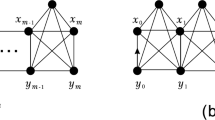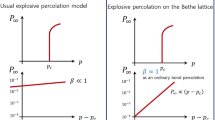Abstract
An irreversible AB-type reaction with ring formation is analyzed. The distributions of chains and cyclics are deduced as functions of statei, using a method in which every particle is enumerated, where statei is related to the extent of the reaction,D=i/N 0. The numbers of the chain and the cyclic x-mers in statek are given, respectively, by
whereP i-1 {x, L} andP i-1 {x, R} are probabilities of chain-propagation and ring formation, respectively, in statei-1.
The chain distribution from the above equations agrees with the most probable one in the case where the chain propagation occurs exclusively (e.g., a concentrated solution), while the ring distribution obeys the exponential lawN Rx ∞x −5/2, which is identical with the equilibrium case. The theory was examined using cycloalkane formation by Knipe and Stirling. Agreement between the theory and experimental observations is found to be considerably favorable for five- and six-membered ring formation.
Similar content being viewed by others
Abbreviations
- N 0 :
-
Total number of units (or functional group)
- C 0=N 0/N A ·V :
-
Initial concentration (N A : Avogadro's number)
- i, k :
-
Reacted number of units (statei andk)
- ξ k :
-
Reacted number of units in chain molecules
- Ξ k :
-
Total number of units in chain molecules
- L x :
-
Chain x-mers
- N x,i :
-
Number of chain x-mers in statei
- R x :
-
Cyclic x-mers
- N Rx,i :
-
Number of cyclic x-mers in statei
- [N Rx ]=N Rx /V :
-
Concentration of ring x-mers
- [N Rx ]=N Rx /N 0 :
-
Yield of ring x-mers
- D=k/N 0 :
-
Extent of reaction in statek
- D *=ξ k /Ξ k :
-
Extent of reaction of chain molecules in statek
- P Lx,i =N x,i /(N 0-i):
-
Probability that a chain x-mer will be formed in statei
- P i {x, L}:
-
Probability that an xth unit will chain-propagate in statei
- P i {x, R}:
-
Probability that an xth unit will cyclize in statei
- P{x, δω/δr):
-
Flory's cyclization probability (probability that an end of an x-mer goes into a small angle δω, subject to the restriction that the same end must go into a small volume δr in close proximity to another end)
- P{a; b):
-
P{a∩b}
- W x (δr):
-
Kuhn's cyclization probability (probability that one end of an x-mer goes into small volume δr around an-other end)
- k L :
-
Chain propagation rate constant
- k Rx :
-
Cyclization rate constant of an x-mer
- <k Ry > i :
-
Statistical mean cyclization rate constant in statei
References
Kuhn W (1934) Kolloid-Z 68:2
Jacobson H, Stockmayer WH (1950) J Chem Phy 18:1600
Jacobson H, Beckmann CO, Stockmayer WH (1950) J Chem Phy 18:1607
Flory PJ, Semlyen JA (1966) J Am Chem Soc 88:3209
Flory PJ, Suter UW, Mutter M (1976) J Am Chem Soc 98:5733
Gordon M, Temple WB, (1972) Makromol Chem 152:277
Gordon M, Temple WB (1972) Makromol Chem 160:263
Stanford JL, Stepto RFT (1975) J Chem Soc Faraday I-71, 1292:1308
Yuan X, Masters AJ, Nicholas CV, Booth C (1988) Makromol Chem 189:823
Sarmoria C, Valles E, Miller DR (1986) Macromol Chem Macromol Symp 2:69
Dostal H, Raff R (1936) Monatsch 68:188 Z Physik Chem B32:11
Hermans JJ (1965) Makromol Chem 87:21
Rolando RJ, Macosko CW (1987) Macromolecules 20:2707
Flory PJ (1936) J Am Chem Soc 58:1877
Gali C, Illuminati G, Mandolini L, Tamborra P (1977) J Am Chem Soc 99:2591
Ashikaga K, Ito S, Yamamoto M, Nishijima Y (1988) J Am Chem Soc 110:198
Carothers WH (1931) Chem Revs 8:353
Illuminati G, Mandolini L (1981) Acc Chem Res 14:95
Knipe AC, Stirling CJM (1968) J Chem Soc (B) Phys Org 67
Glasstone S, Laidler KJ, Eyring H (1971) The Theory of Rate Process. McGraw-Hill Book Company, Inc, New York
Laidler KJ (1965) Chemical Kinetics, Second Edition, TATA McGraw-Hill Publishing Company Ltd, Bombay
Author information
Authors and Affiliations
Rights and permissions
About this article
Cite this article
Suematsu, K., Okamoto, T. Theory of ring formation in irreversible system: AB model. Colloid Polym Sci 270, 421–430 (1992). https://doi.org/10.1007/BF00665984
Received:
Accepted:
Issue Date:
DOI: https://doi.org/10.1007/BF00665984




